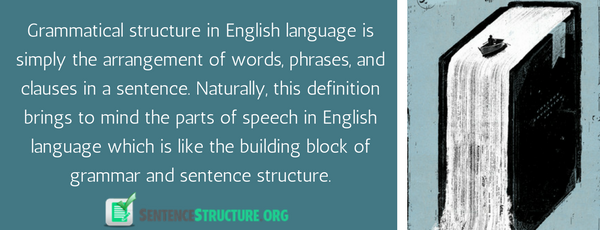In English language structure and grammar, there are specified ways of using words to achieve the right grammatical structure in sentences. In an informal setting (and even in some professional situations), these specifics have been thrown out the window simply because it is too formal, or as a result of lack of knowledge of it. If you write a lot, you should not be in that group of writers that think “it is not necessary to stick to these grammar sentence structure rules, because, in the end, all that matters is that you get to communicate”. Communication is of utmost importance, but if you have to write it down, and you do not do it the right way, you just may end up not communicating at all; we all need help with sentence structure and grammar from time to time. The term structure is really important in everything in this life, and so is it in spoken and written English. What exactly is it, and how can you check for it in your work? Do you need a quality simple compound or complex sentence checker tool?
What Is Grammatical Structure in English Language?
Grammatical structure in English language is simply the arrangement of words, phrases, and clauses in a sentence. Naturally, this definition brings to mind the parts of speech in English language which is like the building block of grammar and sentence structure. It is not just enough to know what these parts of speech are, it pays to know how they are used in communicating, how they are organized to form phrases, grammar and sentence structures that can efficiently make sense to the reader or listener. So the structure and organization of a sentence is what grammatical structures in English language is all about, and it is greatly dependent on what is called the “syntax or syntactic structure”. The grammatical structure in English language demands that words and phrases are arranged in a certain manner to create a well-formed sentence; that is what syntactic structure is all about.
Types of Sentence Structure
There are four basic types of sentence structure in English language.
They are as follows:
- Simple sentence
- Compound sentence
- Complex sentence
- Compound-complex sentence
A good understanding of four of these basic sentence structure types will help with sentence structure and grammar. Here is a brief overview of what they are and some of their examples
A simple sentence is simply a sentence with a grammar structure containing only one independent clause and no dependent clauses at all.
Examples:
- He went home after meeting
- Jimmy loves potatoes
- Mother is a teacher
These are examples of the simplest grammar and sentence structures in the English language. They form the basis of other more complex sentences.
Grammar and sentence structures that have two or more simple sentences are defined as compound sentences. They are just like simple sentences, but at least two times more than what can be obtained from simple sentences; talking about two or more independent clauses.
Examples:
- Sarah went to school; lily slept at home.
- I was running late but I decided to take the bus
- Ella swept the floor, and Tim washed the window.
The notable thing about compound sentences is that no matter how your grammar structure is presented, it signals to the reader that you are discussing two different ideas that are equally important.
Another grammar structure considered one of the basic types of English structure is the complex sentence. This grammar structure contains an independent clause (or main clause) and at least one independent clause. So, the main clause and one or more dependent clauses all put together in a sentence with appropriate conjunction or pronoun is all it takes to come up a complex grammar structure in English language.
Examples:
- Desmond laughed when his father dropped the hot kettle upside down on the floor
- Because she was so smart, Jane was always one of the best in her class
- She learned a memorable lesson about cheating after she changed the mark on her report card last year.
As you can see, the complex sentence is more complex than the other grammar structures discussed earlier. You need to know this about better sentence structure English grammar.
Of all the most basic types of grammatical structures in English language, the compound-complex structure is the most complex. It combines elements of the compound and complex grammar structures, and as such is the most sophisticated type of sentence you can use.
Examples:
- Her blue car was cleaned new, bright and sparkling on the road, but the tires do not run smooth, as though it needs some repairs and replacements.
- She gave me another of her cold keen look, and I could see that she was again asking herself I was responsible for breaking down the air conditioner in the common room.
- In the company, everyone is of the opinion that I have no superiors since I exhibit so much confidence and interact in an assertive manner with everyone, but I do not think I have any inferiors either, because, to me, all men are equal.
Understanding compound-complex grammatical structure in English language will help you take your writing to a new level of complexity in a really good way. The English grammar sentence structure rules must be followed. This is basically all you need to know about the most common sentence structures in English language, and quite frankly, they can come through for you in any form of writing you may wish to do.
Other really good factors to all of these, which are as efficient as the basic types of grammatical structure in helping with cool sentence structure and grammar formation, are the:
- Parts of speech
- Sentence coordination
- Adjective Clauses
- Appositives
- Adverb Clauses
- Absolute phrases
- Participial phrases
- Four functional types of sentences
All of these can help with sentence structure and grammar formation in writing and speaking. It is one thing to know how to make correct English sentence; it is another thing to use them correctly in writing. With constant practice, anyone can learn all these and get used to using perfect grammatical structures in the English language.

How to Check Grammatical Structures for Mistakes
If you pay close attention, you will notice from the examples of the grammar structures above, that punctuation can be everything. The meaning of a sentence can be totally altered depending on the punctuations used in the sentence. You may not readily know or see this in your content as a writer, but that is not to say that you should go right ahead and write wrong grammar structures all the time. You can always consult the second party to help you out with checking for wrong grammatical structures; which can take more time than it took to write, or you can just use of grammar checker tool to check your written sentences for incorrect grammar structures in as little time as possible.
Our free online English grammar checker is a simple to use software application developed to help writers write the best they can with no form of errors in their works. It is the sentence structure for dummies tool you need to make your English better. For the fact that you are a human being, you are bound to make mistakes every now and then as you write. And even after editing, there are times you miss out on important errors that need to be corrected even after going through your document. This is not always as a result of your inability to write, it is because as human beings, we a susceptible to err; so we all need help with sentence structure grammar formation. So far, it is obvious that even the most articulate professional writer needs our grammar checker tool to make sure their works are in perfect condition at all times.
Impeccable Sentence Structure Corrector Online
Improve your text by removing sentence structure mistakes through our specialized parts of speech checker tool online
Challenges in Correcting Sentence Structure
Before going into the challenges, let’s examine what is sentence structure. A meaningful clause with a subject, predicate, verb, and object starting with a capital letter and ending with a period is called a complete sentence structure. Correcting sentence structure in the English language is governed by numerous interlinked as well as independent English sentence structure rules. It is a complex process to find, fix, and define sentence structure issues while editing a professional document. You need a full grasp of grammatical concepts and rules as well as strong writing and editing skillset and experience to accomplish this task. Almost all writers, especially those who use English as a second language (ESL), face some uphill challenges in correcting the sentence structure; a few of those major challenges include:
Having Extensive Command over Grammar and Linguistic Rules
The first and most important challenge of any new learner or writer to correct sentence structures is to understand and establish a full command over numerous grammatical and linguistic rules that govern the correct formation of a sentence. Among such rules, sentence format, tenses, active and passive voices, direct and indirect narration, correct use of parts of speech, proper punctuation, sentence fragment rules, and others are a few to name. For an ESL writer, it is the most fundamental challenge to cope with correcting the grammatical structure examples in writing.
Controlling Intervention of Native Language Paradigm
A sizeable number of English writers use English as a second language other than a few native-speaking countries like the UK, USA, Canada, Australia, and New Zealand. For non-native writers, it is a big challenge to control the innate paradigm about sentence structures and the way they create writings for obtaining certain goals. They make mistakes by mixing up the native prototyping in their writings. This is called the interference of the native language, which causes serious issues in correcting English sentence structures for non-native writers.
Overcoming Disparity in Inter-Language Grammar Rules
Similar to native language interference, the grammatical and writing rules in different languages are different. Non-native writers initially learn the grammatical rules of their native language; those rules keep following them while learning English sentences. But in English, numerous rules are different and some rules are extra, which are not available in many other languages such as the use of articles and a few others. Thus, this becomes a big challenge for ESL writers to overcome the disparity in inter-language grammar rules.
Differentiating Regular and Irregular Conjugation of Verb and Adjectives
Another very unique type of challenge the writers, especially ESL writers, face is the differentiation between the irregular and regular changes in the formation of different forms of verbs and degrees of adjectives. This irregular formation or conjugation of verbs and adjectives is not governed by any specific grammar rule. They have been adopted as an evolution of language. If a few rules apply, most of them have numerous exceptions. Thus, it is a big challenge for writers to discern between those two types of variations.
Understanding the Correct Use of Articles in English Sentences
Articles are a few very special things in the English language. They look very simple and easy but their correct use is highly tricky and complex. Everyone, an ESL writer, feels the heat of using it correctly in sentences. A large number of mistakes occur due to the misuse of articles. It poses a serious challenge for writers to correct sentence structures.
Our Grammar Checker Tool and Grammar Structures
There are a host of things out tool can do to help with sentence structure and grammar correctness:
- Confidence: our grammar and sentence structure checker tool will not write for you or give you ideas on what to write, you need to do all that yourself. But once you know what you want and you as much as attempt to put it down in writing, the tool can go all the way to make it perfect as you write your article and to convey the right meaning to your readers and provide you help with grammar and sentence structure. This boosts your confidence in writing and in English language generally (for people who may still be learning how to speak English).
- Saves time: it is understandable when all you want to do is write and not go back to it to check for one error or the other. Proofreading can be a daunting task to a lot of people. Our tools have features that can proofread your work in very little time and produce a flawless work with correct grammar and sentence structures. People that are in short of time can really benefit from this one.
- Increases knowledge: some people have all the time in the world, as well as the best ideas and reasons to write, but they may be lacking in the knowledge of grammatical structures in English language. Using this tool will help such people check grammar and sentence structure online, grammar formations, and also enlighten them on the use of words and punctuations in English language. This can help them become better in the language generally.













